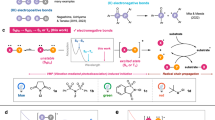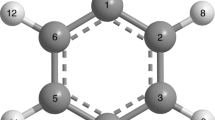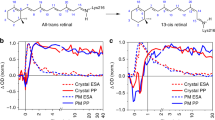Abstract
FROM a study of the action of ultra-violet light on monolayers of proteins, Mitchell1 suggested that tyrosine absorption leads to breakage of the —CONH— bond adjacent to the chromophore. According to Pauling and Niemann2 the C—N linkage has the lowest bond energy and should, therefore, be the first to break when energy is supplied to the molecule. Mitchell's model experiments for proteins with stearyl anilide suffer from the drawback that the phenyl group is directly adjacent to the —CONH— link, but Carpenter3 has shown that, with benzyl stearyl amine and β-phenyl ethyl stearyl amine, cleavage also occurs where the benzene ring and the —CONH— linkage are separated by one or two —CH2— groups.
This is a preview of subscription content, access via your institution
Access options
Subscribe to this journal
Receive 51 print issues and online access
$199.00 per year
only $3.90 per issue
Buy this article
- Purchase on Springer Link
- Instant access to full article PDF
Prices may be subject to local taxes which are calculated during checkout
Similar content being viewed by others
References
Mitchell, J. S., Proc. Roy. Soc., A, 155, 696 (1936); Nature, 137, 509 (1936).
Pauling, L., and Niemann, C., J. Amer. Chem. Soc., 61, 1860 (1939). See also Rideal, E. K., and Mitchell, J. S., Proc. Roy. Soc., A, 159, 206 (1937).
Carpenter, D. C., J. Amer. Chem. Soc., 62, 289 (1940).
Van Slyke, D. D., Dillon, R. T., MacFayden, D. A., and Hamilton P., J. Biol. Chem., 141, 627, 671 (1941).
Carpenter, D. C., J. Franklin Inst., 232, 76 (1941).
Abderhalden, E., and Haas, R., Z. physiol. Chem., 155, 202 (1926). Eckstein, H. C., and Lieben, F., Biochem. Z., 263, 366 (1933). Rao, G. G., and Dhar, N. R., J. Ind. Chem. Soc., 11, 617 (1934). Guillaume, A., and Tanret, G., C.R. Acad. Sci., Paris, 201, 1057 (1935); Bull. soc. chim. biol., 18, 556 (1936).
Weizmann, C., Hirshberg, Y., and Bergmann, E., J. Amer. Chem. Soc., 60, 1799 (1938).
Allen, A. J., Steiger, R. E., Magill, M. A., and Franklin, R. G., Biochem. J., 31, 195 (1937).
Levy, B., M.S. Thesis, Polytechnic Inst., Brooklyn (1948).
McLaren, A. D., and Pearson, S., J. Polymer Sci., 4, 45 (1949).
McLaren, A. D., in “Advances in Enzymology’ (Interscience, N.Y., vol. 9, in the press).
Author information
Authors and Affiliations
Rights and permissions
About this article
Cite this article
MANDL, I., MCLAREN, A. Quantum Yields for Photolysis of the Peptide Bond at 2537 A.. Nature 164, 749–750 (1949). https://doi.org/10.1038/164749b0
Issue Date:
DOI: https://doi.org/10.1038/164749b0
Comments
By submitting a comment you agree to abide by our Terms and Community Guidelines. If you find something abusive or that does not comply with our terms or guidelines please flag it as inappropriate.



